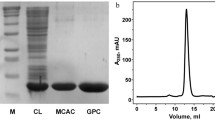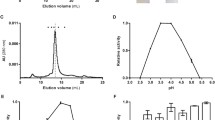Abstract
Proteolytic activity and a subtilisin inhibitor (NSI) were detected in Natrialba magadii cells. The proteolytic activity was due to two different proteases: a ∼90-kDa metallo protease (NMP) produced during exponential growth and a 246-kDa serine protease (NSP) detected in the stationary phase. Both proteases were detected in the cytosolic fraction. NSI activity was maximal during early stages of growth and decreased in the stationary phase. NSI is a 35-kDa thermosensitive protein; it inhibits NSP activity but has no effect on NMP, and it was detected as a soluble or membrane-bound protein depending on the growth phase. Our results suggest that NSI may regulate NSP activity in vivo and that this protease may have a role in stationary phase cells. To our knowledge, this is the first report on the occurrence of protease inhibitors in Archaea.
Similar content being viewed by others
Author information
Authors and Affiliations
Additional information
Received: 4 May 2002 / Accepted: 10 July 2002
Rights and permissions
About this article
Cite this article
Giménez, M., Sánchez, J. & De Castro, R. Detection of an Intracellular Protease Inhibitor in Archaea. Curr Microbiol 46, 0334–0339 (2003). https://doi.org/10.1007/s00284-002-3861-z
Issue Date:
DOI: https://doi.org/10.1007/s00284-002-3861-z




